-
Posts
14,343 -
Joined
-
Last visited
-
Days Won
25
Content Type
Profiles
Forums
Blogs
Gallery
Events
Store
Posts posted by Ed_Haynes
-
-
Army of India Medal, 1799-1826
It was a simple matter to modify the pattern from the First Sikh War medal for the retrospective medal established in 1851 to cover a range of campaigns in India from 1803-1826 (despite the official dates, a Seringapatnam clasp was disallowed).
A standard "general service" medal was established with clasps for each separate campaign.
This, for Assye, was awarded to "DURMAJEE ROW 4th LIGHT CAVy".

 0
0 -
Sutlej Medal, 1845-46
The medal for the First Sikh War represents a deviation from the established pattern in several significant ways:
1- The medals were routinely named.
2- A new ribbon was used. (All those repetive "India Ribbons" had come to be seen as boring.)
2- A medal was issued for each battle (there were four), but subsequent battle participation was represneted by a clasp added to the ribbon, rather than a combined medal. This is revolutionary!
A new pattern is established here.
The specimen shown is for Moodkee with clasp for Ferozeshur, named to "Sepoy Ramjecawun Singh 73rd N. I.".
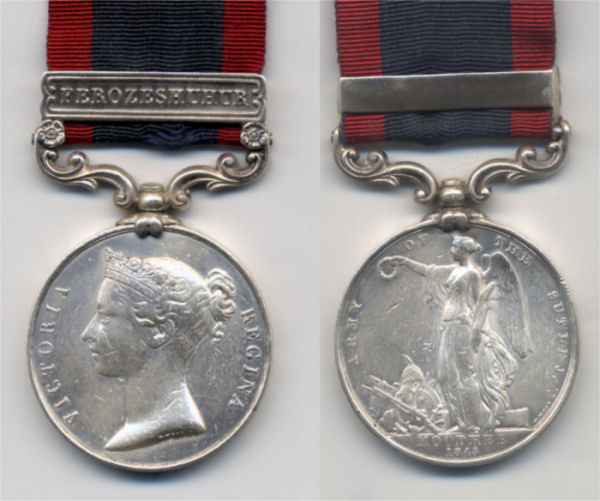
 0
0 -
Gwalior Stars, 1843
Similar problems arose with the campaign stars for the Gwalior Campaign of 1843, when two stars were struck for the major battles of that conflict:
1- Maharajapoor
2- Punniar
The stars were struck from cannon captured in the battle (anticipating what would be done later for the Victoria Cross) and were issued for both battles. Originally, they were to be worn directly on teh tunic, but most stars wera later adapted for wear on the "India Ribbon".
This specimen shown, for Punniar, was awarded and named to "Sepoy Hunnoommun Sing, 50th Native Infy.".

 0
0 -
Scinde Campaign, 1843
Continuing the earlier pattern, the Britist conquest of Sind in 1843 (giving rise to the famous one-word telegram from the conquering British general: "Peccavi") gave rise to a set of overlapping battle-specific medals:
1- Meanee
2- Hyderabad
3- Meanee/Hyderabad
One thing was becoming clear in this campaign, however, that issuing three distinct medalds for the same campaign was very expensive.
The well-loved and well-polished medal shown here, for Meanee/Hyderabad, is named to "JOODDEE JADDOO CAMEL BATY".
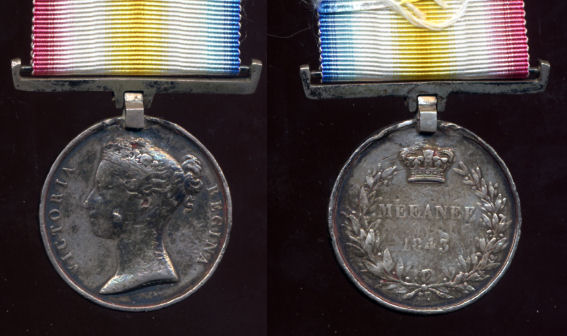
 0
0 -
While it was issued by the Honourable East India Company, paid for by them, and could be seen as an "Indian Medal", the medal for the Opium War in China, 1841-42, seems so far afield that I'll do no more than make passing reference to it here.
0 -
Medals for the First Afghan War, 1841-42
As the First Afghan War was complex (as would be true for successor wars in that area), so were the medals for the conflict complex (as would be true for successor wars in that area).
In general, and grossly simplified, a set of conflict-specific medals emerged, growing out of the earlier patterns. A set of seven medals were awarded for individual battles/campaigns:
1- Candahar [Kandahar]
2- Cabul [Kabul] (also spelled as "Cabvl")
3- Ghuznee [Ghazni] and Cabul
4- Candahar, Ghuznee, and Cabul
5- Jellalabad [Jalalabad] (in two varieties)
6- Khelat-i-Ghizie [Khelat-i-Ghilzai]
This set of medals was also important, for it was the first to use what would become the ubiquitous "India Ribbon", the rainbow pattern ribbon that would be used on so many medals, through the Secoind Afghan War. Said to represent the colors of an Indian sunrise, the ribbon proved to be immensely expensive to manufacture and was subject to fast fading once that Indian sun got in the sky.
For an example, I show a Cabul Medal below.
For more information, see: http://faculty.winthrop.edu/haynese/medals/Afghan/first.html

 0
0 -
Ghuznee Medal, 1839
Although originally established in the summer/fall of 1839 by Amir Dost Muhammad of Afghanistan for award to both Afghan and British troops for participation in the assault on the fortress at Ghazni on 23 July 1839 (the fortress was invested on 21 July), the medal was "adopted" by the East India Company on 23 November 1842 after Dost Muhammad's fall and is treated here as if it were a British medal. The Queen had extender her permission for Crown troops to wear the Afghan medal in March 1841.
It was the first of the Company's medals to be occasionally (thought not routinely) named. This one is named to "Dost Kumal, Bengal Sappers and Miners" (the 2nd and 3rd companies of Bengal Sappers and Miners served in the Bengal Column, under Maj-Gen. Sir W. Cotton).

 0
0 -
Order of Merit
Not a campaign medal, but it must be mentioned here. Among the "inventions" of the East India Company (at least in terms of British phaleristics) is the idea of rewarding others than the most senior officers for gallantry. In 1837 (seventeen years before the DCM and nineteen years before the VC) teh Order fo Merit was established in three classes.
The Order of Merit (later renamed as the "Indian Order of Merit" after Edward VII unknowingly invented another award of the same name) was awarded to all Indians in Company service for gallantry in combat. In usual cases, a person would be admitted to the third class for his initial act of bravery and advanced to the second and first classes for subsequent acts of gallantry; the Russian Cross of St. George was the conscious model here. An IOM 1st class was, therefore, the equivalent of a VC with two bars; the VC would not be extended to Indians of the Indian Army until 1911.
The IOM presence a fascinating and complex story, one that has yet to be fully told. (Work is underway, though.)
Even more complex is the Order of British India, created at the same time to reward long and meritorious service by Indian officers.
Both awards would continue until 1947.

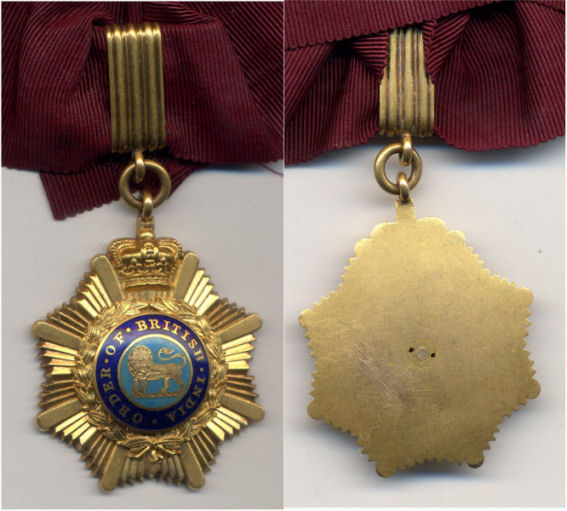

 0
0 -
Coorg Medal, 1837
Awarded not as a campaign medal to the troops involved, but to Coorgi (Karanese) leaders ("chiefs") who supported the Company in its suppression of a "rebellion" in the region in April-May 1837. Awarded in a range of sizes and weights but, roughly, in gold (44) and silver (300). Bronze medals are seen, but they have no official standing; they are probably mint test pieces and the medal proved to be very hard to manufacture.
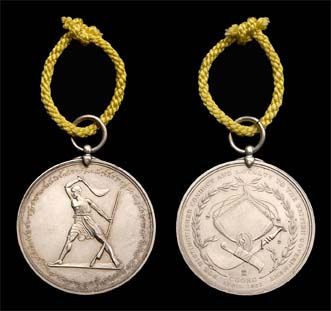
 0
0 -
Burma Medal, 1824-26, gold
A further modification to the pattern came with the medal for the first Burma War on 1824-26. Rather than being suspended around the neck, the medals were now worn froma ribbon. How odd.
Gold medals (750) were awarded to subadars and jemadars, while others received a silver medal (around 24,000). The medals are STILL unnamed (though there are STILL rolls in New Delhi).

 0
0 -
In 1818 a gold (2 issued) and silver (45 issued) medal was issued for gallantry (rather than as a "campaign" medal) in the face of a rebellion in Ceylon.
I'm not showing this here because (1) it was not a "campaign" medal and (2) I don't have an image (it being very rare). Sorry. But I list it anyway.
0 -
Nepal Medal, 1814-16
This medal represents a slight variant of the earlier pattern. It was not awarded as a general campaign medal, but was, rather, awarded only to those soldiers of the Company's forces who had shown especially meritorious service in the war agains Nepal, 1814-16. It was awarded only in silver, regardless of rank (and there was much grumbling over that). A
Others (and Europeans) would have to await the "Nepaul" clasp to the Army of India Medal in 1851.
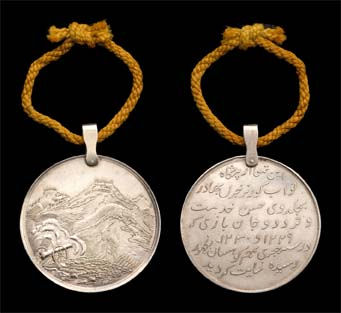
 0
0 -
Medal for the Capture of Java, 1811, gold
Awarded to troops of the East India Company for the capture of the island of Java from the Dutch in 1811. Gold medals (133) were awarded to subadars and jemadars, while others (6519) received the silver medal.
Europeans (even Europeans in Company service) who saw this service would have to await the clasp "Java" for the naval and military general service medals in 1847.
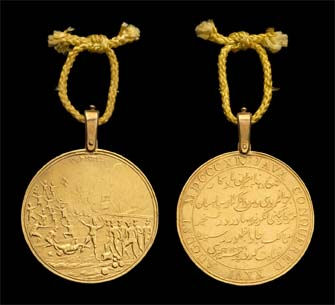
 0
0 -
Medal for the Capture of Rodriguez, Isle of Bourbon, and Isle of France, 1809-10, gold
Awarded on gold (to subadars, 50 issued), and silver (to others, 2200 issued) to troops of the East India Company involved in the capture of the French-held islands in the Indian Ocean of Rodriguez, the Isle of Bourbon (today, Mauritius), and the Isle of France (today, Reunion).
This is a gold medal.
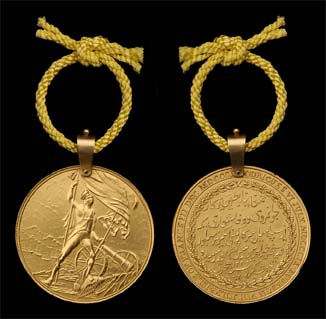
 0
0 -
Egypt 1801, silver
The medal was awarded for the Company troops involved in teh Egyptian campaign against Napoleon in 1801. Awarded in gold to subadars (16 awarded) and in silver to others (2200 awarded).
This is one medal that has always held a strange fascination for me. This is the same medal shown in the latest BB&M.
Not a great scan, sorry.
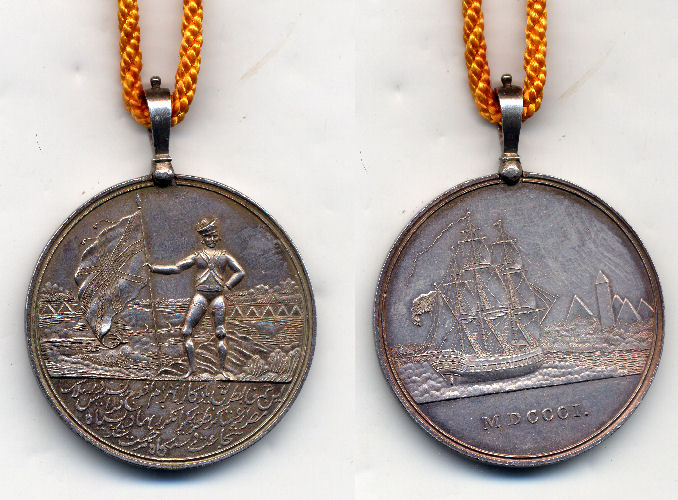
 0
0 -
Seringapatam Medal, 1799, tin
This is a very complex medal.
It was awarded for the campaigns against Tipu Sultan in 1799 and, specifically, for the capture of the foirtress at Seringapatam on 4 May 1799. It was the first medal to be awarded to both Europeans and Indians in the Honourable East India Company's forces. Different scales of award were used for Europeans and for Indfians, and there were even different terms of award for teoops of the Bengal Army and the Madras Army. For example, the medal in bronze was awarded to Indian Officers and NCOs (in the Madras Army) and to Indian NCOs (in the Bengal Army).
The medal shown here, in tin, was warded to enlisted men (in both the Madras and Bengal armies).

 0
0 -
Medal for the Capture of Ceylon, 1795
Awarded for the capture of Ceylon (now, Sri Lanka) from the Dutch in 1795. Awarded in gold to subadars (only 2 awarded) and in silver to all others (121 awarded).

 0
0 -
Mysore Medal, 1790-93
For campaigns against Mysore, 1790-93. Issued in gold (43 mm, to subadars), large silver (43 mm, to jemadars), and small silver (38 mm, to others) for campaigns against Tipu Sultan. This is the small silver medal. Again, rolls survive in New Delhi, but the medal is unnamed.
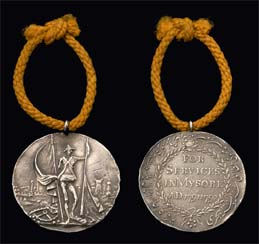
 0
0 -
Deccan Medal, 1778-84
Awarded to Indian officers and men of the Company's forces for the campaigns in western India and Gujarat, 1778-84. Awarded in 40.55 mm gold to subadars, 40.55 mm silver to jemadars, and in small silver (32 mm) to NCOs and ORs. This is the small silver medal. Created 1784. While rolls survive, the medal is unnamed.
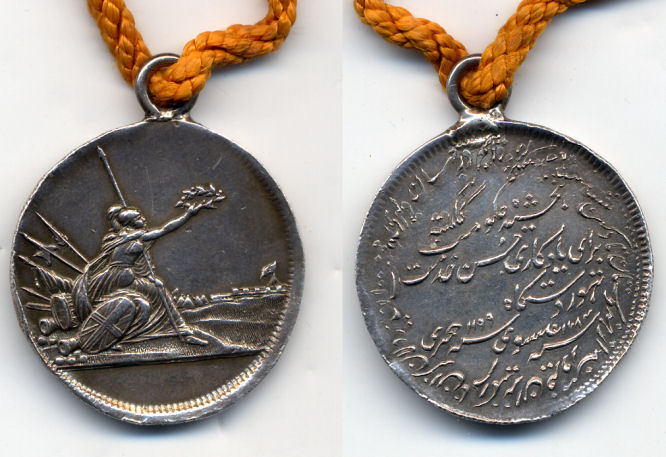
 0
0 -
Monghyr Medal, 1766
The first medal created by the East India Company was for the deployment of Indian troops to quell a mutiny by European officers of the Company's Army at Monghyr in 1766. (An interesting reversal of what some may think of as the common patternms of "mutiny".)
The medal shown below has long been considered to be the Monghyr Medal, but serious questions have been raised as to its identity. This is presented tentatively, with great qualifications. The medal (if this is it, if it was ever issued) was given in gold to Indian officers and in silver to other ranks. The medals were worn around the neck, suspended from a yellow/saffron cord.
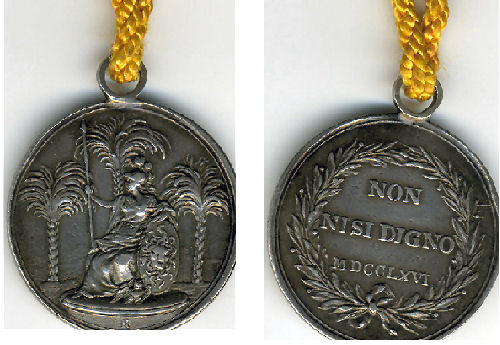
 0
0 -
A question was raised on another thread regarding early Indian campaign medals. The initual query may not have realised what it was about to unleash.
0 -
QE2 crowned 2 June 1953.
0 -
As Chris suggests, 50% "gut" 50% provenance. And for a high ticket group . . . ??
I'd want to see better scans of the DFC and of the naming (are the naming and the date engraved in the same "hand" - oh!).
As India (post-1947 meaning) also named (most of) their WWII medals, things are easier for me than for a "straight" Brit collector, but some 100% groups are also 100% unnamed. For example http://gmic.co.uk/index.php?showtopic=2331&st=6 -- as it came direct from his grandson, I feel safe.
0 -
If there is provenance and documentation beyond the spiffy bronze plaque, this is a group that would attract a lot of interest. The danger, of course, is that the Brits did not name their WWII medals (and any naming on the DFC would have been later, unofficial); this makes the "assembly" of "groups" an active cottage industry (ditto the preperation of mounds of fraudulent paperwork).
The stakes are high. While I don't like quoting prices and while many -- myself included -- criticise the volume, the Medal Yearbook 2006 provides a price guide (of sorts):
DFC 1 bar (attributed) - GBP 2500-4000
39-45 Star - GBP 10-12
ACE Star with F&G clasp - GBP 175-195
Defence Medal - GBP 16-18
War Medal - GBP 10-12
Add these up and add, say, 20-25% (more if these are sexy DFC recommendations) and you see why someone would want to fake such groups.
0




Early (pre-1858) awards for India
in Great Britain: Orders, Gallantry, Campaign Medals
Posted
Punjab Medal, 1848-49
The established pattern was used for the Second Sikh War of 1848-49, in which indepndent Punjab was finally annexed into the expanding territories of the Honourable East India Company.
A standard medal was awarded for service (which could be awarded without clasp if theire was no battle service), and clasps were added for specific battles.
This example has clasps for Goojerat and Mooltan and is named to "PRIVATE. MAUN SING. SCINDE CAMEL. B. C."